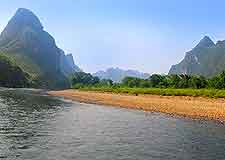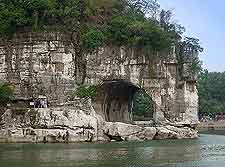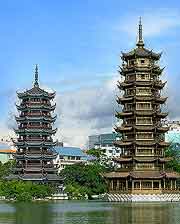Guilin History Facts and Timeline
(Guilin, Guangxi, China)

The unique landscape of Guilin has been celebrated by Chinese poets and painters since it was first discovered in the dawn of humanity. With the city sitting along the banks of the lazy Li River, surrounded by limestone karsts, it's easy to see why people would want to live here.
While never a power centre due to its rather isolated location in south-eastern China, Guilin has been visited by everyone from emperors to minstrels.
Early Prosperity
The history of Guilin didn't really get started until the eras of the Tang and Song dynasties. The small city prospered under these dynasties, but remained a backwater. The dynasties saw it as a useful buffer between the central government in
Beijing and the unruly south-western borderlands. Guilin was where soldiers were stationed while patrolling the borders.
During this period in Guilin history, the city's canal system was built to help ease the transport of food produced in the fertile Yangtze Plain to the farthest southern reaches of the Chinese empire. By the time the Ming and Qing dynasties came along, between 1368 and 1912, Guilin had established itself as a vital link for politics, security and trade between the north and the south.

Ming Emperors
The Ming emperors seem to have taken a particularly keen interest in Guilin, even going so far as to build palaces and have themselves entombed here after they died. Much of the city's historic atmosphere is connected to the Ming, with the power and the beauty of this dynasty being clearly evident in monuments like the Jingjiang Palace and the various imperial tombs that can be found in the area.
Centre of Resistance
The strategic location of Guilin has made the city's history one of struggle and frontier mentality. Everyone, from warlords to revolutionaries, has used this city as their base over the centuries.
During the Japanese occupation, Guilin attracted a vibrant expat population of intellectuals, who helped turn the city into the base of operations during the War of Resistance against Japan. Dr. Sun Yat-sen, a leader of this movement against the Japanese, assigned Guilin as one of the Northern Expedition Army headquarters. Today, however, the main struggle is for tourist dollars.

Ethnic Diversity
Throughout the long imperial era, the southern ends of China were always home to myriad indigenous groups, who lived with or under the power of the day. Often it was a brutal oppressive relationship, but the groups held on to their culture and traditions to mark the history of Guilin as one of China's most diverse and interesting.
Today, there are 11 distinct ethnic groups living in and around Guilin, including the Yao, the Miao and the Zhuang. They are an integral component of the city and a major reason (along with the natural scenery) why it is such a popular tourist attraction for both Chinese and foreign visitors.
 The unique landscape of Guilin has been celebrated by Chinese poets and painters since it was first discovered in the dawn of humanity. With the city sitting along the banks of the lazy Li River, surrounded by limestone karsts, it's easy to see why people would want to live here.
The unique landscape of Guilin has been celebrated by Chinese poets and painters since it was first discovered in the dawn of humanity. With the city sitting along the banks of the lazy Li River, surrounded by limestone karsts, it's easy to see why people would want to live here.
